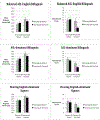Bilingual word recognition in deaf and hearing signers: Effects of proficiency and language dominance on cross-language activation
- PMID: 32982006
- PMCID: PMC7518396
- DOI: 10.1177/0267658313503467
Bilingual word recognition in deaf and hearing signers: Effects of proficiency and language dominance on cross-language activation
Abstract
Recent evidence demonstrates that American Sign Language signs are active during print word recognition in deaf bilinguals who are highly proficient in both ASL and English. In the present study, we investigate whether signs are active during print word recognition in two groups of unbalanced bilinguals: deaf ASL-dominant and hearing English-dominant bilinguals. Participants judged the semantic relatedness of word pairs in English. Critically, a subset of both the semantically related and unrelated English word pairs had phonologically related translations in ASL, but participants were never shown any ASL signs during the experiment. Deaf ASL-dominant bilinguals (Experiment 1) were faster when semantically related English word pairs had similar form translations in ASL, but slower when semantically unrelated words had similar form translations in ASL, indicating that ASL signs are engaged during English print word recognition in these ASL-dominant signers. Hearing English-dominant bilinguals (Experiment 2) were also slower to respond to semantically unrelated English word pairs with similar form translations in ASL, but no facilitation effects were observed in this population. The results provide evidence that the interactive nature of lexical processing in bilinguals is impervious to language modality.
Keywords: Bilingualism; Deaf; Sign Language; Word Recognition.
Figures


Similar articles
-
The time course of cross-language activation in deaf ASL-English bilinguals.Biling (Camb Engl). 2017 Mar;20(2):337-350. doi: 10.1017/S136672891500067X. Epub 2015 Oct 21. Biling (Camb Engl). 2017. PMID: 31320833 Free PMC article.
-
ERP Evidence for Co-Activation of English Words during Recognition of American Sign Language Signs.Brain Sci. 2019 Jun 21;9(6):148. doi: 10.3390/brainsci9060148. Brain Sci. 2019. PMID: 31234356 Free PMC article.
-
Language development in deaf bilinguals: Deaf middle school students co-activate written English and American Sign Language during lexical processing.Cognition. 2021 Jun;211:104642. doi: 10.1016/j.cognition.2021.104642. Epub 2021 Mar 20. Cognition. 2021. PMID: 33752155
-
When deaf signers read English: do written words activate their sign translations?Cognition. 2011 Feb;118(2):286-92. doi: 10.1016/j.cognition.2010.11.006. Epub 2010 Dec 8. Cognition. 2011. PMID: 21145047 Free PMC article.
-
The bimodal bilingual brain: effects of sign language experience.Brain Lang. 2009 May-Jun;109(2-3):124-32. doi: 10.1016/j.bandl.2008.03.005. Epub 2008 May 8. Brain Lang. 2009. PMID: 18471869 Free PMC article. Review.
Cited by
-
Cross-modal and cross-language activation in bilinguals reveals lexical competition even when words or signs are unheard or unseen.Proc Natl Acad Sci U S A. 2022 Sep 6;119(36):e2203906119. doi: 10.1073/pnas.2203906119. Epub 2022 Aug 29. Proc Natl Acad Sci U S A. 2022. PMID: 36037359 Free PMC article.
-
With or without semantic mediation: retrieval of lexical representations in sign production.J Deaf Stud Deaf Educ. 2015 Apr;20(2):163-71. doi: 10.1093/deafed/enu045. Epub 2015 Jan 1. J Deaf Stud Deaf Educ. 2015. PMID: 25583708 Free PMC article.
-
Implicit co-activation of American Sign Language in deaf readers: An ERP study.Brain Lang. 2017 Jul;170:50-61. doi: 10.1016/j.bandl.2017.03.004. Epub 2017 Apr 10. Brain Lang. 2017. PMID: 28407510 Free PMC article.
-
Emerging ASL Distinctions in Sign-Speech Bilinguals' Signs and Co-speech Gestures in Placement Descriptions.Front Psychol. 2021 Aug 3;12:686485. doi: 10.3389/fpsyg.2021.686485. eCollection 2021. Front Psychol. 2021. PMID: 34413812 Free PMC article.
-
Automaticity of lexical access in deaf and hearing bilinguals: Cross-linguistic evidence from the color Stroop task across five languages.Cognition. 2021 Jul;212:104659. doi: 10.1016/j.cognition.2021.104659. Epub 2021 Mar 31. Cognition. 2021. PMID: 33798950 Free PMC article.
References
-
- Adam R (2011, June) Unimodal bilingualism in BSL and ISL. Paper presented at the 8th International Symposium on Bilingualism, Oslo, Norway.
-
- Battison R (1978) Lexical borrowing in American Sign Language. Silver Spring, MD: Linstok Press.
-
- Bijeljac-Babic R, Biardeau A and Grainger J (1997) Masked orthographic priming in bilingual word recognition. Memory & Cognition 25: 447–457. - PubMed
-
- Bishop M and Hicks S (2005) Orange Eyes: Bimodal bilingualism in hearing adult users of American Sign Language. Sign Language Studies 5 (2): 188–230.
-
- Boudreault P (2005) Deaf interpreters In Janzen T (ed) Topics in signed language interpreting: Theory and practice. Amsterdam: John Benjamins, 323–353.
